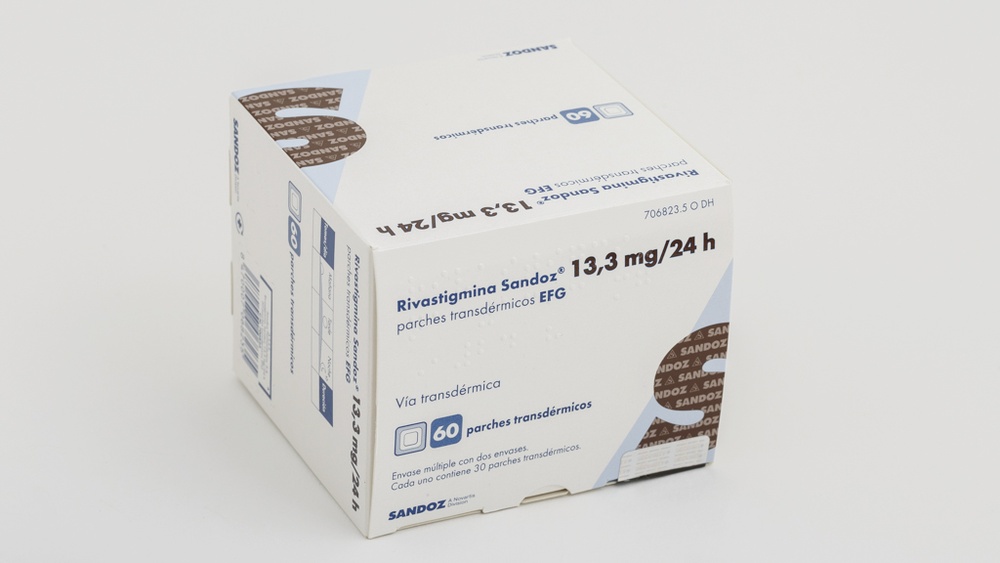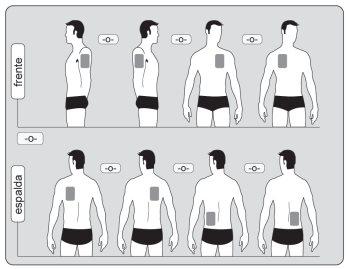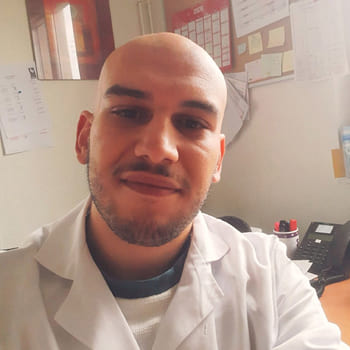

ALZERTA 13,3 mg/24h AUTOCLIVANTES TRANSDÉRMICOS

Pergunte a um médico sobre a prescrição de ALZERTA 13,3 mg/24h AUTOCLIVANTES TRANSDÉRMICOS

Como usar ALZERTA 13,3 mg/24h AUTOCLIVANTES TRANSDÉRMICOS
Introdução
Prospecto: Informação para o utilizador
Alzerta 13,3 mg/24 h patches transdérmicos EFG
Rivastigmina
Leia todo o prospecto detenidamente antes de começar a usar este medicamento, porque contém informações importantes para si.
- Conserva este prospecto, porque pode ter que voltar a lê-lo.
- Se tiver alguma dúvida, consulte o seu médico ou farmacêutico.
- Este medicamento foi-lhe prescrito apenas para si, e não deve dá-lo a outras pessoas, embora tenham os mesmos sintomas que si, porque pode prejudicá-las.
- Se experimentar efeitos adversos, consulte o seu médico ou farmacêutico, mesmo que se trate de efeitos adversos que não aparecem neste prospecto. Ver secção 4.
Conteúdo do prospecto
- O que é Alzerta e para que é utilizado
- O que precisa saber antes de começar a usar Alzerta
- Como usar Alzerta
- Posíveis efeitos adversos
- Conservação de Alzerta
- Conteúdo do envase e informação adicional
1. O que é Alzerta e para que é utilizado
O princípio ativo de Alzerta é rivastigmina.
A rivastigmina pertence ao grupo dos inibidores da colinesterase. Em pacientes com demência de Alzheimer, determinadas células nervosas morrem no cérebro, provocando níveis baixos do neurotransmissor acetilcolina (uma substância que permite que as células nervosas se comuniquem entre si). A rivastigmina actua bloqueando as enzimas que rompem a acetilcolina: acetilcolinesterase e butirilcolinesterase. Bloqueando estas enzimas, a rivastigmina permite o aumento de acetilcolina no cérebro, ajudando a reduzir os sintomas da doença de Alzheimer.
Alzerta é utilizado para o tratamento de pacientes adultos com demência de Alzheimer de leve a moderadamente grave, um distúrbio progressivo do cérebro que afeta gradualmente a memória, capacidade intelectual e o comportamento.
2. O que precisa saber antes de começar a usar Alzerta
Não use Alzerta
- se é alérgico à rivastigmina (o princípio ativo de Alzerta) ou a algum dos outros componentes deste medicamento (incluídos na secção 6).
- se já teve uma reação alérgica a um medicamento semelhante (derivados do carbamato).
- se tem uma reação da pele que se estende além do tamanho do patch, se há uma reação local mais intensa (tais como bolhas, inflamação da pele, inchaço) e se não há melhoria durante as 48 horas após a retirada do patch transdérmico.
Se se encontrar em alguma destas situações, informe o seu médico e não use Alzerta patches transdérmicos.
Advertências e precauções
Consulte o seu médico antes de começar a usar Alzerta:
- se tem ou já teve algum problema cardíaco, como ritmo cardíaco (pulso) irregular ou lento, prolongação de QTc, antecedentes familiares de prolongação de QTc, torsade de pointes, ou se tem um nível baixo em sangue de potássio ou de magnésio.
- se tem ou já teve uma úlcera de estômago ativa.
- se tem ou já teve dificuldades ao urinar.
- se tem ou já teve convulsões.
- se tem ou já teve asma ou uma doença respiratória grave.
- se sofre tremores.
- se tem peso corporal baixo.
- se tem reações gastrointestinais, tais como sensação de náuseas, vómitos e diarreia. Pode desidratar-se (perda de grande quantidade de fluido) se os vómitos ou diarreia forem prolongados.
- se tem problemas do fígado (insuficiência hepática).
Se se encontrar em alguma destas situações, pode ser que o seu médico considere necessário realizar um maior seguimento enquanto estiver em tratamento.
Se não usou os patches durante mais de três dias, não se ponha outro antes de consultar o seu médico.
Crianças e adolescentes
Não existe experiência do uso deste medicamento na população pediátrica no tratamento da doença de Alzheimer.
Outros medicamentos e Alzerta
Informa o seu médico ou farmacêutico se está a tomar, tomou recentemente ou pode ter que tomar qualquer outro medicamento.
Este medicamento pode interferir com medicamentos anticolinérgicos, alguns dos quais são medicamentos utilizados para aliviar os calambres ou espasmos estomacais (p. ex., diciclomina), para o tratamento da doença de Parkinson (p. ex., amantadina) ou para prevenir os mareios por movimento (p. ex., difenhidramina, escopolamina, ou meclizina).
Este medicamento não deve ser administrado ao mesmo tempo que metoclopramida (um medicamento utilizado para aliviar ou prevenir as náuseas e os vómitos). A tomada dos dois medicamentos juntos pode causar problemas, como rigidez nas extremidades e tremor de mãos.
Em caso de que tenha que se submeter a uma intervenção cirúrgica enquanto está a utilizar este medicamento, informe o seu médico de que o está a utilizar, porque pode potenciar excessivamente os efeitos de alguns relaxantes musculares da anestesia.
Deve ter precaução quando se utiliza este medicamento com beta-bloqueadores (medicamentos, como atenolol, utilizados para tratar a hipertensão, angina e outras afeções cardíacas). A tomada dos dois medicamentos juntos pode causar complicações, como o descenso da frequência cardíaca (bradicardia), que pode dar lugar a desmaios ou perdas de consciência.
Deve ter precaução quando se utiliza Alzerta com outros medicamentos que podem afetar o ritmo cardíaco ou o sistema elétrico do coração (prolongação QT).
Gravidez, lactação e fertilidade
Se está grávida ou em período de lactação, acredita que possa estar grávida ou tem intenção de engravidar, consulte o seu médico ou farmacêutico antes de utilizar este medicamento.
Se está grávida, é necessário avaliar os benefícios do uso deste medicamento face aos possíveis efeitos adversos para o feto. Não se deve utilizar este medicamento durante a gravidez, a menos que seja claramente necessário.
Não deve amamentar durante o tratamento com este medicamento.
Condução e uso de máquinas
O seu médico informá-lo-á se a sua doença lhe permite conduzir ou utilizar maquinaria de forma segura. Este medicamento pode causar tonturas e confusão grave. Se se sentir tonto ou confuso, não conduza nem utilize maquinaria, nem desenvolva outras tarefas que requeiram a sua atenção.
3. Como usar Alzerta
Siga exatamente as instruções de administração deste medicamento indicadas pelo seu médico. Em caso de dúvida, consulte novamente o seu médico ou farmacêutico.
Como iniciar o tratamento
O seu médico indicar-lhe-á a dosagem deste medicamento mais adequada para o seu caso.
- Normalmente, começa-se o tratamento com Alzerta 4,6 mg/24 h.
- A dosagem diária habitual recomendada é Alzerta 9,5 mg/24 h. Se esta dosagem for bem tolerada, o médico que o trata pode considerar aumentar a dosagem para 13,3 mg/24 h.
- Leve apenas um patch deste medicamento ao mesmo tempo e substitua o patch por outro novo às 24 horas.
Durante o tratamento, o seu médico pode ajustar a dosagem consoante as suas necessidades individuais.
Se não usou os patches durante mais de três dias, não se ponha outro antes de consultar o seu médico. O tratamento com patch transdérmico pode ser reiniciado à mesma dosagem se o tratamento não for interrompido durante mais de três dias. De outra forma, o seu médico fará com que reinicie o tratamento com Alzerta 4,6 mg/24 h.
Este medicamento pode ser utilizado com alimentos, bebida e álcool.
Onde colocar o seu patch Alzerta transdérmico
- Antes de se pôr um patch, certifique-se de que a pele está limpa, seca e sem pêlo, sem pós, óleo, hidratante ou loção que impeçam que o patch se pegue bem à pele, sem cortes, vermelhidão ou irritações.
- Retire cuidadosamente qualquer patch que esteja a usar antes de se pôr um novo.O uso de múltiplos patches no seu corpo pode expô-lo a uma quantidade excessiva deste medicamento e isso pode ser potencialmente perigoso.
- Coloque apenas UMpatch por dia em APENAS UMAdas zonas possíveis, como se mostra nos seguintes diagramas:
- parte superior do braço esquerdo oudireito
- parte superior esquerda ousuperior direita do peito (evitando os seios nas mulheres)
- parte superior esquerda ousuperior direita das costas
- parte inferior esquerda ouinferior direita das costas
Cada 24horas retire o patch anterior antes de se pôr UM patch novo em APENAS UMA das seguintes zonas possíveis. |

Cada vez que se muda o patch, deve retirar o patch do dia anterior antes de se pôr o novo patch em um local diferente da pele (por exemplo, um dia no lado direito do corpo e no dia seguinte no lado esquerdo; ou um dia na parte superior do corpo e no dia seguinte na parte inferior). Espere pelo menos 14 dias para voltar a se pôr um patch novo exatamente na mesma área da pele.
Comoaplicar o seu patch Alzerta transdérmico
Os patches de Alzerta são finos, de cor castanha e pegam à pele. Cada patch está em um envelope que o protege até que se vá pô-lo. Não abra o envelope nem retire o patch até o momento de se pô-lo
| Retire cuidadosamente o patch existente antes de se pôr um novo. Os pacientes que iniciam o tratamento pela primeira vez e para pacientes que reiniciam o tratamento com rivastigmina após a interrupção do tratamento, devem começar pela segunda figura. |
| Cada patch está em um envelope protector individual. Só se deve abrir o envelope quando se vai pôr o patch. Corte o envelope com tesouras, ao longo da linha de pontos, mas não mais além da linha indicada. Abra o envelope. Não corte toda a longitude do envelope para evitar danificar o patch. Retire o patch do envelope. |
| Uma lâmina protectora cobre o lado adesivo do patch. Retire a primeira folha da lâmina protectora sem tocar com os dedos o lado adesivo do patch. |
| Coloque o lado adesivo do patch sobre a parte superior ou inferior das costas ou na parte superior do braço ou no peito e, em seguida, retire a segunda folha da lâmina protectora. |
| Pressione firmemente o patch contra a pele com a palma da mão durante um mínimo de 30 segundos e certifique-se de que as bordas se têm pegado bem. |
IMPORTANTE:
- Retire o patch anterior antes de se pôr UM patch novo.
- Apenas um patch por dia.
- Não corte o patch em pedaços.
- Pressione firmemente o patch contra a pele com a palma da mão durante um mínimo de 30segundos.
Se isso o ajudar, pode escrever sobre o patch, por exemplo, o dia da semana, com um bolígrafo de ponta fina arredondada.
Deve usar o patch continuamente até ao momento de o mudar por outro novo. Quando se pôr um novo patch, pode experimentar com diferentes zonas para encontrar as que lhe resultem mais confortáveis e onde a roupa não roce com o patch.
Como retirar o seu patch Alzerta transdérmico
Tire suavemente de uma das bordas do patch para despegá-lo lentamente da pele. Se restarem resíduos adesivos sobre a pele, embeba a área com água morna e sabão suave ou utilize óleo de bebê para eliminá-los. Não se deve utilizar álcool ou outros líquidos dissolventes (removedores de esmalte de unhas ou outros dissolventes).
Depois de retirar o patch, deve lavar as mãos com sabão ou água. Em caso de contacto com os olhos ou se os olhos se enrubecem após a manipulação do patch, deve lavá-los imediatamente com água abundante e pedir conselho médico se os sintomas não se resolverem.
Pode usar o seu patch Alzerta transdérmico quando se banhar, nadar ou se expor ao sol?
- O banho, a natação ou a ducha não devem afetar o patch. Certifique-se de que não se despega parcialmente enquanto realiza estas atividades.
- Não exponha o patch a uma fonte de calor externa (p. ex., luz solar excessiva, sauna, solarium) durante períodos de tempo longos.
O que fazer se se lhe cair um patch
Se se lhe cair um patch, ponha um novo para o resto daquele dia e mude-o no dia seguinte à hora habitual.
Quando e durante quanto tempo deve pôr o seu patch Alzerta transdérmico?
- Para beneficiar-se do tratamento, deve pôr um novo patch todos os dias, preferencialmente à mesma hora.
- Use apenas um patch deste medicamento ao mesmo tempo e substitua o patch por outro novo às 24 horas.
Se usar mais Alzerta do que deve
Se acidentalmente se pôs mais de um patch, retire todos os patches da pele e informe disso ao seu médico ou ligue para o Serviço de Informação Toxicológica, telefone: 91 562 04 20 (indicando o medicamento e a quantidade administrada). É possível que necessite de atenção médica. Algumas pessoas que tomaram acidentalmente quantidades excessivas de rivastigmina tiveram sensação de náuseas, vómitos, diarreia, tensão alta e alucinações. Pode ocorrer também um abrandamento da frequência cardíaca e desmaios.
Se esquecer de usar Alzerta
Se se aperceber que esqueceu de pôr um patch, ponha-o imediatamente. No dia seguinte, ponha o seguinte patch à hora habitual. Não se ponha dois patches para compensar o que esqueceu.
Se interromper o tratamento com Alzerta
Informa o seu médico ou farmacêutico se deixar de utilizar os patches.
Se tiver alguma outra dúvida sobre o uso deste medicamento, pergunte ao seu médico ou farmacêutico.
4. Efeitos adversos possíveis
Tal como todos os medicamentos, Alzerta patchs transdérmicos pode produzir efeitos adversos, embora nem todas as pessoas os sofram.
Pode ter efeitos adversos com mais frequência ao começar o seu tratamento ou quando a dose for aumentada. Geralmente, os efeitos adversos desaparecerão lentamente à medida que o seu organismo se acostumar com o medicamento.
Se notar algum dos seguintes efeitos adversos que podem ser graves, retire o patch e informe imediatamente o seu médico.
Frequentes(podem afetar até 1 em cada 10 pessoas)
- Perda de apetite
- Sensação de tontura
- Sensação de agitação ou adormecimento
- Incontinência urinária (incapacidade de controlar a urina).
Pouco frequentes(podem afetar até 1 em cada 100 pessoas)
- Problemas com o ritmo do coração, como ritmo cardíaco lento
- Ver coisas que realmente não existem (alucinações)
- Úlcera de estômago
- Desidratação (perda de grande quantidade de líquido)
- Hiperatividade (alto nível de atividade, inquietude)
- Agressividade
Raros(podem afetar até 1 em cada 1.000 pessoas)
- Quedas
Muito raros(podem afetar até 1 em cada 10.000 pessoas)
- Rigidez dos braços e pernas
- Tremor nas mãos
Não conhecidos(não podem ser estimados a partir dos dados disponíveis)
- Reação alérgica no local de aplicação do patch, como bolhas ou inflamação da pele
- Piora dos sinais de doença de Parkinson – como tremor, rigidez e dificuldade de movimento
- Síndrome de Pisa (condição que envolve contração muscular involuntária e inclinação anormal do corpo e da cabeça para um lado)
- Inflamação do pâncreas – os sinais incluem dor na parte superior do estômago, frequentemente acompanhada de sensação de náuseas ou vômitos
- Ritmo cardíaco rápido ou irregular
- Pressão arterial alta
- Crises epilépticas (convulsões)
- Distúrbios hepáticos (coloração amarelada da pele, amarelamento do branco dos olhos, escurecimento anormal da urina ou náuseas inexplicáveis, vômitos, cansaço e perda de apetite)
- Alterações nos exames que mostram o funcionamento do fígado
- Sensação de inquietude
- Pesadelos
Se notar algum dos efeitos adversos listados acima, retire o patch e informe imediatamente o seu médico.
Outros efeitos adversos experimentados com rivastigmina cápsulas ou solução oral e que podem ocorrer com os patchs:
Frequentes(podem afetar até 1 em cada 10 pessoas)
- Saliva excessiva
- Perda de apetite
- Sensação de agitação
- Sensação de mal-estar geral
- Tremor ou sensação de confusão
- Aumento da sudorese
Pouco frequentes(podem afetar até 1 em cada 100 pessoas)
- Ritmo cardíaco irregular (p. ex. ritmo cardíaco rápido)
- Dificuldade para dormir
- Quedas acidentais
Raros(podem afetar até 1 em cada 1.000 pessoas)
- Crises epilépticas (convulsões)
- Úlcera no intestino
- Dor no peito – provavelmente causada por espasmo no coração
Muito raros(podem afetar até 1 em cada 10.000 pessoas)
- Pressão arterial alta
- Inflamação do pâncreas – os sinais incluem dor grave na parte superior do estômago, frequentemente com sensação de náuseas ou vômitos
- Sangramento gastrointestinal – manifesta-se como sangue nas fezes ou ao vomitar
- Ver coisas que não existem (alucinações)
- Algumas pessoas que sofreram vômitos intensos tiveram desgarro de parte do tubo digestivo que conecta a boca ao estômago (esôfago)
Comunicação de efeitos adversos
Se experimentar algum tipo de efeito adverso, consulte o seu médico ou farmacêutico, mesmo que se trate de possíveis efeitos adversos que não aparecem neste folheto. Também pode comunicá-los diretamente através do Sistema Espanhol de Farmacovigilância de Medicamentos de Uso Humano, Website: www.notificaRAM.es. Mediante a comunicação de efeitos adversos, você pode contribuir para fornecer mais informações sobre a segurança deste medicamento.
5. Conservação de Alzerta
- Mantenha este medicamento fora da vista e do alcance das crianças.
- Não utilize este medicamento após a data de validade que aparece na caixa e no sobre após CAD. A data de validade é o último dia do mês que se indica.
- Conservar o patch transdérmico dentro do sobre até o seu uso.
- Não utilize nenhum patch se observar que está danificado ou mostra sinais de manipulação.
Após retirar um patch, dobre-o ao meio com o lado adesivo para dentro e pressione. Após introduzi-lo no sobre original, descarte o patch. Não toque os olhos com os dedos e lave as mãos com água e sabão após retirar o patch. Se a sua lixeira doméstica for eliminada por incineração, pode jogar o patch na lixeira de sua casa.
Os medicamentos não devem ser jogados nos ralos ou na lixeira. Deposite os recipientes e os medicamentos que não precisa no Ponto SIGRE da farmácia. Em caso de dúvida, pergunte ao seu farmacêutico como se livrar dos recipientes e dos medicamentos que não precisa. Dessa forma, ajudará a proteger o meio ambiente.
6. Conteúdo do envase e informações adicionais
Composição de Alzerta
O princípio ativo é rivastigmina.
Cada patch transdérmico libera 13,3 mg de rivastigmina em 24 horas. Cada patch transdérmico de 12,8 cm2 contém 19,2 mg de rivastigmina.
Os demais componentes são película de poliéster revestida de polietileno/resina termoplástica/alumínio, poli [(2-etilhexil) acrilato, vinilacetato], poliisobuteno de peso molecular médio e alto, sílica coloidal anidra, parafina líquida leve, película de poliéster revestida de fluoropolímero, tinta de impressão laranja.
Aspecto do produto e conteúdo do envase
Cada patch transdérmico é um patch fino de forma circular. A camada externa é de cor marrom e traz impresso em tinta laranja: “RIV-TDS 13.3 mg/24h”.
Cada patch transdérmico vem selado em um sobre.
Alzerta 13,3 mg/24 h patchs transdérmicos EFG, estão disponíveis em envases que contêm 7 ou 30 sobres e em envases múltiplos que contêm 60 (2x30) ou 90 (3x30) sobres.
Pode ser que apenas alguns tamanhos de envases sejam comercializados.
Titular da autorização de comercialização e responsável pela fabricação
Titular da autorização de comercialização
Esteve Pharmaceuticals, S.A.
Passeig de la Zona Franca, 109
08038 Barcelona
Espanha
Responsável pela fabricação
Luye Pharma AG
Am Windfeld 35
83714 Miesbach
Alemanha
Data da última revisão deste folheto:Dezembro2024
A informação detalhada e atualizada deste medicamento está disponível na página Web da Agência Espanhola de Medicamentos e Produtos Sanitários (AEMPS)http://www.aemps.gob.es/
- País de registo
- Substância ativa
- Requer receita médicaSim
- Fabricante
- Esta informação é apenas para referência e não constitui aconselhamento médico. Consulte sempre um médico antes de tomar qualquer medicamento. A Oladoctor não se responsabiliza por decisões médicas baseadas neste conteúdo.
- Alternativas a ALZERTA 13,3 mg/24h AUTOCLIVANTES TRANSDÉRMICOSForma farmacêutica: ADESIVO TRANSDÉRMICO, 4,6 mg/24 hSubstância ativa: rivastigmineFabricante: Esteve Pharmaceuticals S.A.Requer receita médicaForma farmacêutica: PENSO TRANSDÉRMICO, 9,5 mg/24hSubstância ativa: rivastigmineFabricante: Esteve Pharmaceuticals S.A.Requer receita médicaForma farmacêutica: ADESIVO TRANSDÉRMICO, 4.6 mg/24 hSubstância ativa: rivastigmineFabricante: Esteve Pharmaceuticals S.A.Requer receita médica
Alternativas a ALZERTA 13,3 mg/24h AUTOCLIVANTES TRANSDÉRMICOS noutros países
As melhores alternativas com o mesmo princípio ativo e efeito terapêutico.
Alternativa a ALZERTA 13,3 mg/24h AUTOCLIVANTES TRANSDÉRMICOS em Polonia
Alternativa a ALZERTA 13,3 mg/24h AUTOCLIVANTES TRANSDÉRMICOS em Ucrania
Médicos online para ALZERTA 13,3 mg/24h AUTOCLIVANTES TRANSDÉRMICOS
Avaliação de posologia, efeitos secundários, interações, contraindicações e renovação da receita de ALZERTA 13,3 mg/24h AUTOCLIVANTES TRANSDÉRMICOS – sujeita a avaliação médica e regras locais.
















